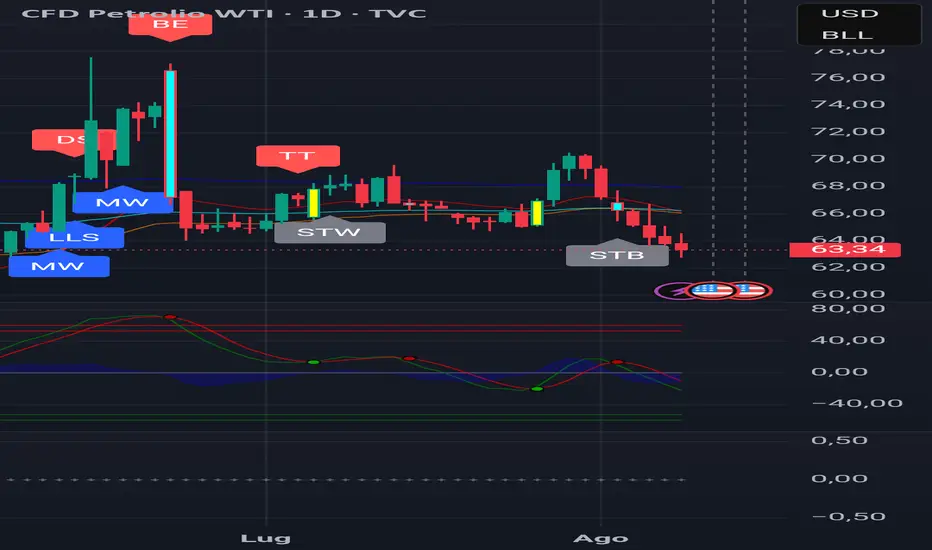$MARKETSCOM:OIL
1) More barrels are coming (or not leaving)
2) Demand side is cooling / less elastic at these prices
3) Macro & trade policy headwinds
Tariff escalation: U.S. imposed an extra 25% duty on Indian imports (many lines now ~50%); secondary-sanctions chatter targets buyers of Russian crude (China/India). Weekly tape closed ~5% lower on these headlines.
Why bearish: tighter global trade, firmer USD → lower oil beta.
India’s pivot raises costs: dropping Russian barrels would add $9–12bn to India’s crude bill (SBI est.), implying demand elasticity to higher costs and a swing back to costlier Mideast barrels.
Why bearish: higher feedstock costs curb marginal demand.
4) Physical/flows pointing softer for flat price
U.S. crude exports fell to a ~4-yr low in July (~3.1 mb/d) as WTI lost overseas appeal. China bought zero for a fifth straight month.
Why bearish: weaker U.S. export pull reduces prompt tightness.
Time-spreads have eased from highs (Brent 6-month backwardation has been drifting; several desks flag softer prompt spreads through summer).
Why bearish: when backwardation compresses, it signals looser forward balances.
Brent/WTI price action: market ended the week ~5% lower on Russia-talks + tariff uncertainty; near-term rallies are being sold.
5) Positioning is not stretched long
Managed-money net length has eroded into early Aug (WTI net length sub-90k; latest print ~78–88k depending on cut), reducing squeeze risk.
Why bearish: with fewer longs to squeeze, rips may fade faster.
6) Saudi OSPs—bullish for spreads, not necessarily for flat price
Aramco raised Sept OSP to Asia: Arab Light +$1 to +$3.20 vs Oman/Dubai; other grades +$0.70–$1.20.
Interpretation: supports backwardation/sour diffs, but doesn’t defeat macro/tariff drags on outright prices.
Near-term catalysts (CEST)
1) More barrels are coming (or not leaving)
- OPEC+ adds ~ 547–548 kb/d in September; next chance to “pause/reverse” isn’t until 7 Sep (JMMC) → supply hits first, policy rethink later.
- Why bearish: incremental supply lands into a soft macro tape; rallies face overhead offers.
- Russia export plan raised after refinery outages: loading program lifted above 1.77 mb/d, requiring extra Aframaxes; pressure on India to curb imports is ongoing, but flows are still being arranged.
- Why bearish: seaborne availability persists despite sanction chatter.
- Iran exports & floating storage stay elevated: trackers put exports ~1.8–2.2 mb/d with floating storage 25–70+ Mb clustered off Malaysia/Singapore and moving closer to China.
- Why bearish: ready-to-draw barrels cap time-spread squeezes.
2) Demand side is cooling / less elastic at these prices
- IEA OMR (Jul): 2025 demand growth ~700 kb/d, the slowest since 2009 (ex-COVID). Supply +2.1 mb/d in 2025 → surplus risk unless growth surprises.
- Why bearish: baseline growth can’t absorb new OPEC+ barrels cleanly.
- China pulse: Manufacturing PMI 49.5 (Jul)—contraction on export weakness.
- Why bearish: the marginal buyer is slowing, limiting upside beta.
- U.S. gasoline/fuels: EIA shows crude −3.0 Mb to 423.7 Mb (−6% vs 5-yr) on high runs (96.9%), but product draws are modest (gasoline −1.3 Mb; distillate −0.6 Mb). Next WPSR Aug 13.
- Why bearish for flat price: strong runs ≠ booming demand; shoulder season looms.
3) Macro & trade policy headwinds
Tariff escalation: U.S. imposed an extra 25% duty on Indian imports (many lines now ~50%); secondary-sanctions chatter targets buyers of Russian crude (China/India). Weekly tape closed ~5% lower on these headlines.
Why bearish: tighter global trade, firmer USD → lower oil beta.
India’s pivot raises costs: dropping Russian barrels would add $9–12bn to India’s crude bill (SBI est.), implying demand elasticity to higher costs and a swing back to costlier Mideast barrels.
Why bearish: higher feedstock costs curb marginal demand.
4) Physical/flows pointing softer for flat price
U.S. crude exports fell to a ~4-yr low in July (~3.1 mb/d) as WTI lost overseas appeal. China bought zero for a fifth straight month.
Why bearish: weaker U.S. export pull reduces prompt tightness.
Time-spreads have eased from highs (Brent 6-month backwardation has been drifting; several desks flag softer prompt spreads through summer).
Why bearish: when backwardation compresses, it signals looser forward balances.
Brent/WTI price action: market ended the week ~5% lower on Russia-talks + tariff uncertainty; near-term rallies are being sold.
5) Positioning is not stretched long
Managed-money net length has eroded into early Aug (WTI net length sub-90k; latest print ~78–88k depending on cut), reducing squeeze risk.
Why bearish: with fewer longs to squeeze, rips may fade faster.
6) Saudi OSPs—bullish for spreads, not necessarily for flat price
Aramco raised Sept OSP to Asia: Arab Light +$1 to +$3.20 vs Oman/Dubai; other grades +$0.70–$1.20.
Interpretation: supports backwardation/sour diffs, but doesn’t defeat macro/tariff drags on outright prices.
Near-term catalysts (CEST)
- Tue 12 Aug — EIA STEO (macro demand/supply revisions).
- Wed 13 Aug, 10:00 — IEA OMR (Aug); 16:30 — EIA WPSR (inventories).
- Sun 7 Sep — OPEC+ JMMC (first chance to pause/reverse the Sept add).
Declinazione di responsabilità
Le informazioni ed i contenuti pubblicati non costituiscono in alcun modo una sollecitazione ad investire o ad operare nei mercati finanziari. Non sono inoltre fornite o supportate da TradingView. Maggiori dettagli nelle Condizioni d'uso.
Declinazione di responsabilità
Le informazioni ed i contenuti pubblicati non costituiscono in alcun modo una sollecitazione ad investire o ad operare nei mercati finanziari. Non sono inoltre fornite o supportate da TradingView. Maggiori dettagli nelle Condizioni d'uso.
